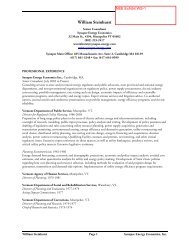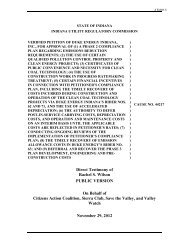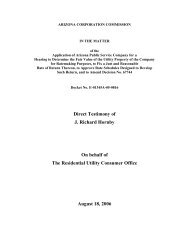Best Practices in Energy Efficiency Program Screening - Synapse ...
Best Practices in Energy Efficiency Program Screening - Synapse ...
Best Practices in Energy Efficiency Program Screening - Synapse ...
Create successful ePaper yourself
Turn your PDF publications into a flip-book with our unique Google optimized e-Paper software.
a greater negative impact on program cost-effectiveness than for measures with shorter<br />
lives.<br />
Figure 5.1. Cost-Effectiveness with Different Discount Rates<br />
Source: The 2012 energy efficiency plan for our example utility, with modified assumptions as noted.<br />
5.2 Study Period<br />
<strong>Energy</strong> efficiency measures produce sav<strong>in</strong>gs over the full course of their useful lives.<br />
Depend<strong>in</strong>g on the measure, the useful life can be as long as 20 years or more. <strong>Energy</strong><br />
efficiency screen<strong>in</strong>g practices should <strong>in</strong>clude the sav<strong>in</strong>gs available over the full life of the<br />
energy efficiency measure. This requires us<strong>in</strong>g a study period that is long enough to<br />
capture sav<strong>in</strong>gs over their full useful lives. Shorter study periods will skew the costeffectiveness<br />
results aga<strong>in</strong>st energy efficiency.<br />
Ideally, a study period of at least 25 years should be used to evaluate the costeffectiveness<br />
of energy efficiency resources, given that some energy efficiency<br />
measures affect exist<strong>in</strong>g and new build<strong>in</strong>gs and thus can last at least 30 years. After 30<br />
years the effect of discount<strong>in</strong>g significantly reduces energy efficiency benefits, even <strong>in</strong><br />
cases where relatively low discount rates are used, and thus there is little advantage to<br />
us<strong>in</strong>g a study period beyond 25 years.<br />
If, for some reason, program adm<strong>in</strong>istrators do not have the <strong>in</strong>puts or the models to<br />
account for 25 years, then other methodologies should be used to capture the benefits <strong>in</strong><br />
the years that are not <strong>in</strong>cluded <strong>in</strong> the study period. For example, “end effects”<br />
calculations can be made to adjust the benefits that are derived us<strong>in</strong>g a shortened study<br />
period.<br />
If there is reasonable data regard<strong>in</strong>g the degradation of measure performance, or about<br />
early failure of energy efficiency measures, then these factors should be accounted for<br />
separately <strong>in</strong> the program screen<strong>in</strong>g process by adjust<strong>in</strong>g the sav<strong>in</strong>gs or the lifetime<br />
assumptions for the measure.<br />
| 54 <strong>Best</strong> <strong>Practices</strong> <strong>in</strong> <strong>Energy</strong> <strong>Efficiency</strong> <strong>Program</strong> Screen<strong>in</strong>g | www.nhpci.org







